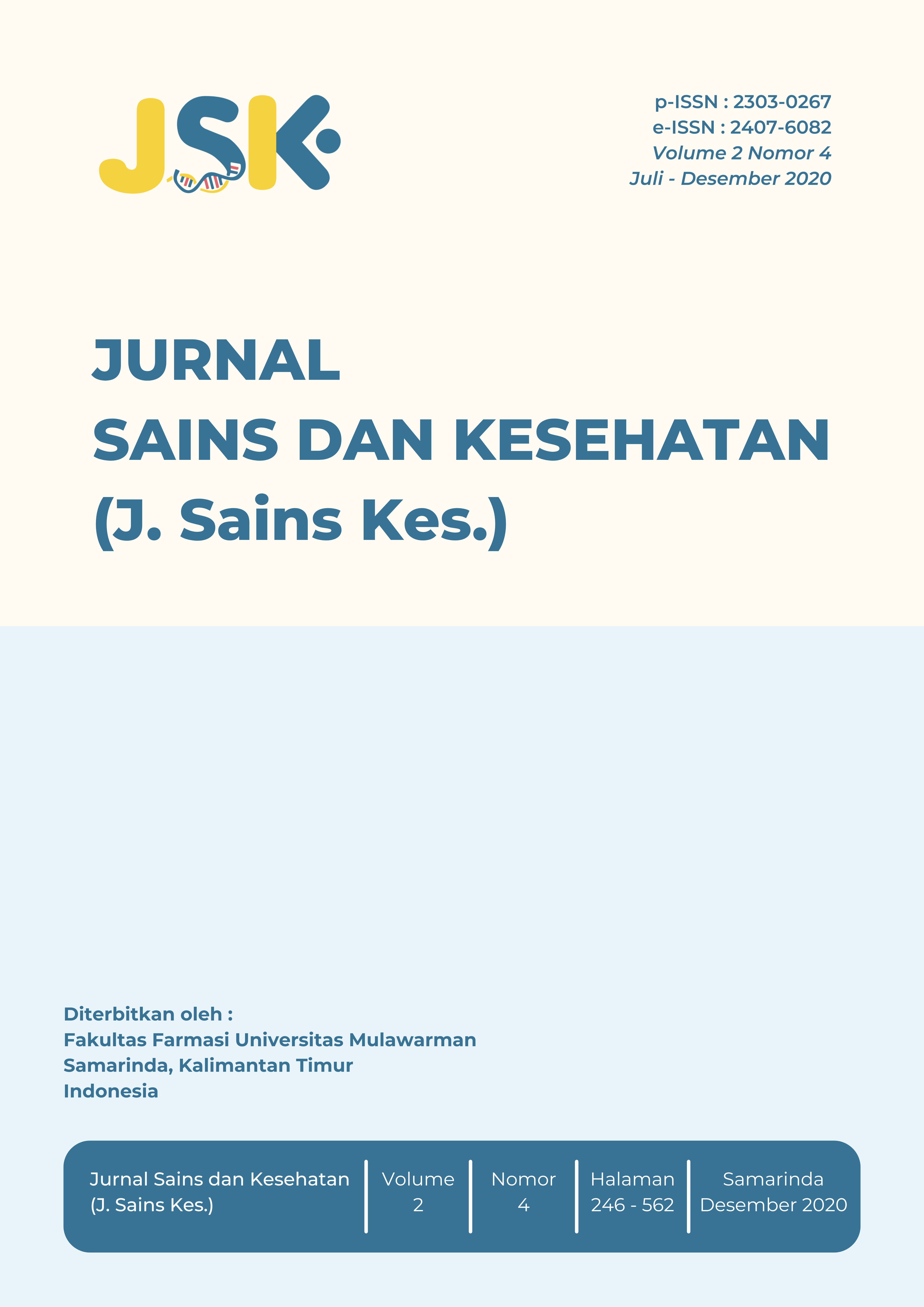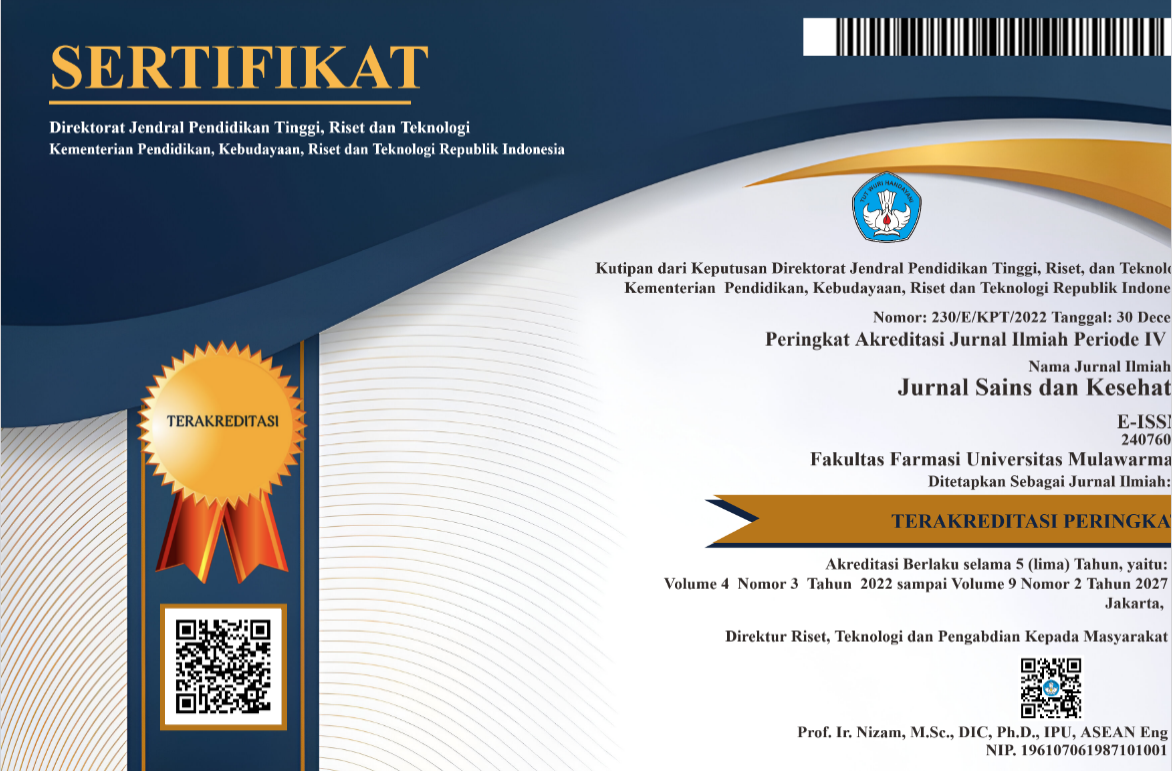Pengaruh Zat Besi dan Seng terhadap Perkembangan Balita serta Implementasinya
Keywords:
perkembangan balita, seng, zat besiAbstract
References
[1] Global Research on Developmental Disabilities Collaborators. Developmental disabilities among children younger than 5 years in 195 countries and territories, 1990-2016: a systematic analysis for the Global Burden of Disease Study 2016.Lancet Glob Health. 2018;6(10):e1100-e1121.
[2] Gunardi Hartono, Nugraheni Resyana, Yulman Annisa. Growth and developmental delay risk factors among under-five children in an inner-city slum area. Paediatrica Indonesiana. 2019;59,(5):276-83.
[3] Pem Deki. Factors Affecting Early Childhood Growth and Development: Golden 1000 Days. Adv Pract Nurs. 2015;1–7.
[4] Coyle P, Tran N ,Fung JNT, Summers BL, et al. Maternal dietary zinc supplementation prevents aberrant behaviour in an object recognition task in mice off spring exposed to LPS in early pregnancy. BehavBrain Res. 2009;197:210–218.
[5] Melse Boonstra A, Jaiswal N. Iodine de?ciency in pregnancy, infancy and childhood and its consequences for brain development. BestPractResClinEndocrinolMetab. 2010;24:29–38.
[6] Mc Lean, Cogswell M, Egli, et al. Worldwide prevalence of anaemia, who vitamin and mineral nutrition information system,1993-2005. Public Health Nutr. 2009;12:444–454.
[7] Kementerian Kesehatan RI, Badan Penelitian dan Pengembangan Kesehatan (Balitbang). Riset Kesehatan Dasar (Riskesdas) 2012. Jakarta: Laporan Nasional. Balitbang; 2013.
[8] Diana, A., Haszard, J., Purnamasari, D., Nurulazmi, I., Luftimas, D., Rahmania, S., Houghton, L, et al. Iron, zinc, vitamin A and selenium status in a cohort of Indonesian infants after adjusting for inflammation using several different approaches. British Journal of Nutrition. 2017;118(10):30-839.
[9] Ringoringo Harapan Parlindungan. Insidensi defisiensi besi dan anemia defisiensi besi Besi pada Bayi Berusia 0-12 Bulan di Banjarbaru Kalimantan Selatan: studi kohort prospektif. Sari Pediatri. 2009;11:8–14.
[10] Zakaria M Al Hawsawi, Sami A Al-Rehali, Amani M Mahros. High prevalence of iron deficiency anemia in infants attending a well-baby clinic in northwestern Saudi Arabia. Saudi Med J. 2015;36(9):1067–70.
[11] Wessells K Ryan, Brown Kenneth. Estimating the Global Prevalence of Zinc Deficiency: Results Based on Zinc Availability in National Food Supplies and the Prevalence of Stunting. PLoS One. 2012;7(11):e50568.
[12] Özden TA, Gökçay Gülbin, Cantez MS, et al. Copper, zinc and iron levels in infants and their mothers during the first year of life: a prospective study. BMC Pediatr. 2015;15:157.
[13] Erdman JW, Macdonald IA, Zeisel SH. Present Knowledge in Nutrition. Ed 20. Oxford: Wiley Blackwell; 2012.
[14] Ikatan Dokter Anak Indonesia, UKK Nutrisi dan Penyakit. Rekomendasi Praktik Pemberian Makan Berbasis Bukti pada Bayi dan Batita di Indonesia untuk Mencegah Malnutrisi. Jakarta: IDAI; 2015.
[15] Fahmida Umi, Dillon Drupadi. Nutritional Assessment. Ed 2. Jakarta: Seameo Recfon UI; 2013.
[16] McPherson RA, Pincus MR. Henry’s Clinical Diagnosis and Management By Laboratory Methods. Ed 22. New York: Elsevier; 2011.
[17] World Health Organization. Haemoglobin concentrations diagnosis of anaemia and assessment of severity. WHO. 2001.
[18] World Health Organization. Serum ferritin concentrations for the assessment of iron status and iron deficiency in populations. Vitamin and Mineral Nutrition Information System. Geneva, Switzerland: World Health Organization; 2011.
[19] Fretham S.J, Carlson,E.S, Georgieff. The role of iron in learning and memory. Adv Nutr. 2011;2:112–121.
[20] Radlowski EC, Johnson RW. Perinatal iron deficiency and neuro cognitive development. Front Hum Neurosci. 2013;1–11.
[21] Dunnett S, Meldrum A, Muir J. Frontal-striatal disconnection disrupts cognitive performance of the frontal-type in the rat. Neuroscience. 2005;135:1055–1065.
[22] Calabrese F, Guidotti G Middelman, A Racagni,et al. Lack of serotonin transporter alters bdnf expression in the rat brain during early postna-tal development. Mol Neurobiol. 2013;48:244–256.
[23] Georgieff Michael. Iron in the Brain:Its Role in Development and Injury. NeoReviews. 2006;7:e344–51.
[24] Falkingham M, Abdelhamid A, Curtis P, et al. The effects of oral iron supplementation on cognition in older children and adults: a systematic review and meta-analysis. Nutr J. 2010;9(4):1–16.
[25] Idjradinata Ponpon, Pollit Ernesto. Reversal of developmental delays in iron-deficient anaemic infants treated with iron. Lancet. 1993;341:1-4.
[26] Mahan LK, Escott-Stumo S, Raymond Janicel. Krause’s Food and The Nutrition Care Process. Ed 13. United States: Elsevier; 2012.
[27] Hess Sonja Y, Peerson Janet M, King Janet C. Use of serum zinc concentration as an indicator of population zinc status. Food Nutr Bull. 2007;2(3):s403–29
[28] Georgieff MK. Nutrition and the developing brain: nutrient priorities and measurement. AmJClinNutr. 2007;85:614S–620S.
[29] Levenson CW. Regulation of the NMDA receptor: implications for neuropsychological development. NutrRev. 2006;64:428–432.
[30] Rubin Rachael D, Watson Patrick, Duff Melissa C, et al. The role of the hippocampus in flexible cognition and social behavior. Front Hum Neurosc. 2014;1–15.
[31] Corniola Rikki S, Tassabehji Nadine M, Hare Joan, et al. Zinc Deficiency Impairs Neuronal Precursor Cell Proliferation And Induces Apoptosis Via P53-Mediated Mechanisms. Brain Res. 2008;1237:52–61
[32] Black Maureen M, Baqu AH, Zaman K, et al. Iron and zinc supplementation promote motor development and exploratory behavior among Bangladeshi infants. Am J Clin Nutr. 2004;80:903–10.
[33] Gao S, Tu DN, H. Li H, et al. Relationship between zinc and the growth and development of young children. Genet Mol Res. 2015;14(3):9730–8.
[34] Gogia S, Sachdev HS. Zinc supplementation formental and motor development in children. Cochrane Database Syst Rev. 2012;12:1–52.
[35] Hagmeyer Simone, Haderspeck JC, Grabrucker Am, et al. Behavioral impairments in animal models for zinc deficiency. Front Behav Neurosci. 2015;1–16.
[36] Millward, D. Nutrition, infection and stunting: The roles of deficiencies of individual nutrients and foods, and of inflammation, as determinants of reduced linear growth of children. Nutrition Research Reviews. 2017;30(1);50-72
[37] Ali SS. A brief review of risk-factors for growth and developmental delay among preschool children in developing countries. Adv Biomed Res. 2013;2:91.
[38] WHO. Infant and young child feeding. Geneva: WHO Press; 2005.
[39] Finn K, Callen C, Bhatia J. Importance of Dietary Sources of Iron in Infants and Toddlers: Lessons from the FITS Study. Nutrients. 2017;11;9(7). pii: E733.
[40] Ikatan Dokter Anak Indonesia. Suplementasi Besi untuk Anak. Jakarta: IDAI; 2011.
[41] Lozoff Betsy, Jiang Yaping, Li Xing. Low-Dose Iron Supplementation in Infancy Modestly Increases Infant Iron Status at 9 Mo without Decreasing Growth or Increasing Illness in a Randomized Clinical Trial in Rural China. Nutr. 2016;146:612.
[42] WHO. 2016. Guideline: Daily Iron Supplementation. Melalui: https://www.who.int/nutrition/publications/micronutrients/guidelines/daily_iron_sup childrens/en/ [13/03/2020]
Downloads
Published
Issue
Section
How to Cite
Most read articles by the same author(s)
- Intan Aryanti, Rachma Hidana, Yolanda Safitri, M. Ikhsan Jufri, Putrya Hawa, Dwi Monik Purnamasari, Elies Fitriani, Prevalensi Malnutrisi Balita di Desa Karimunting, Kec. Sungai Raya, Kab. Bengkayang, Provinsi Kalimantan Barat , Jurnal Sains dan Kesehatan: Vol. 4 No. 3 (2022): J. Sains Kes.
- Dwi Monik Purnamasari, Grace Joselini Corlesa, Handrian Rahman Purawijaya, Astikahilda Maria Pangemanan, Cahya Wahyudi Januarta, Roy Envito Utama, Adristi Anargya Athallah, Rachma Hidana, Elies Fitriani, Yolanda Safitri, Alfa Januar Krista, Status Gizi Mahasiswa Universitas Pertahanan Republik Indonesia Program S1 Angkatan 1 , Jurnal Sains dan Kesehatan: Vol. 3 No. 6 (2021): J. Sains Kes.
- Dwi Monik Purnamasari, Alika Audrina Hartanto, Inovasi Roti Tawar Cokelat Tinggi Protein dengan Tepung Kedelai, Tepung Daun Kelor, dan Telur untuk Pencegahan Stunting pada Anak , Jurnal Sains dan Kesehatan: Vol. 6 No. 3 (2025)
Similar Articles
- Semuel Piter Irab, Rosmin M. Tingginehe, Yacob Ruru, Keterbatasan Pangan Balita Perkotaan dan Pedesaan Provinsi Papua Indonesia pada Masa Pandemi COVID-19 , Jurnal Sains dan Kesehatan: Vol. 4 No. 1 (2022): J. Sains Kes.
- Dwi Monik Purnamasari, Alika Audrina Hartanto, Inovasi Roti Tawar Cokelat Tinggi Protein dengan Tepung Kedelai, Tepung Daun Kelor, dan Telur untuk Pencegahan Stunting pada Anak , Jurnal Sains dan Kesehatan: Vol. 6 No. 3 (2025)
- Intan Aryanti, Rachma Hidana, Yolanda Safitri, M. Ikhsan Jufri, Putrya Hawa, Dwi Monik Purnamasari, Elies Fitriani, Prevalensi Malnutrisi Balita di Desa Karimunting, Kec. Sungai Raya, Kab. Bengkayang, Provinsi Kalimantan Barat , Jurnal Sains dan Kesehatan: Vol. 4 No. 3 (2022): J. Sains Kes.
- Rifatolistia Tampubolon, Jeanita Fernanda Lasamahu, Bagus Panuntun, Identifikasi Faktor-Faktor Kejadian Anemia pada Ibu Hamil di Kecamatan Amahai Kabupaten Maluku Tengah , Jurnal Sains dan Kesehatan: Vol. 3 No. 4 (2021): J. Sains Kes.
- Raisa Fadilla, Arsyik Ibrahim, Niken Indriyanti, Skrining Fitokimia dan Aktivitas Antikoagulan Sari Buah Melon (Cucumis melo L) Secara In Vivo , Jurnal Sains dan Kesehatan: Vol. 5 No. 3 (2023): J. Sains Kes.
- Adhe Restu Ananda, Sanfia Tesabela Messakh, Dary Dary, Gambaran Status Gizi dan Perkembangan Motorik Anak Usia 3-5 Tahun Di Kelurahan Pulutan, Salatiga , Jurnal Sains dan Kesehatan: Vol. 2 No. 4 (2020): J. Sains Kes.
- Fiane de Fretes, Sanfia Tesabela Messakh, Inel Dina Mariska Saogo, Manajemen Keluarga Terhadap Penanganan ISPA Berulang Pada Balita di Puskesmas Mangunsari Salatiga , Jurnal Sains dan Kesehatan: Vol. 2 No. 4 (2020): J. Sains Kes.
- Arius Togodly , Faktor-Faktor yang Berpengaruh terhadap Kejadian Infeksi Saluran Pernafasan Akut (ISPA) pada Balita di Puskesmas Karubaga Kabupaten Tolikara , Jurnal Sains dan Kesehatan: Vol. 4 No. 4 (2022): J. Sains Kes.
- Aegirine Rafilah Dahlan, Meiliati Aminyoto, Annisa Muhyi, Profil Elektrolit dan Hematologi Pasien Balita Diare Akut dengan Dehidrasi Ringan-Sedang di RSUD Abdoel Wahab Sjahranie Samarinda , Jurnal Sains dan Kesehatan: Vol. 5 No. 4 (2023): J. Sains Kes.
- Rasmala Dewi, Deny Sutrisno, Ryzki Purnamasari, Evaluasi Penggunaan Antibiotik pada Pasien Balita dengan Diagnosa Infeksi Saluran Pernapasan Atas di Puskesmas Koni Kota Jambi , Jurnal Sains dan Kesehatan: Vol. 2 No. 4 (2020): J. Sains Kes.
You may also start an advanced similarity search for this article.




